Modeling and Optimization of Biochar Injection into Blast Furnace to Mitigate the Fossil CO2 Emission
Abstract
1. Introduction
2. Heat and Mass Balance Model (MASMOD)
2.1. Brief Description of MASMOD
- FT = Flame temperature, (°C)
- ΣHi,tuyere injection = sensible enthalpy of all tuyere injectants
- ΔHcombustion = enthalpy of combustions for ½ O2 + C → CO
- sub>∙ ΔHcracking = enthalpy of thermal dissociation of H2O → H2 + ½ O2
- Hcoke, T=0,75*FT = enthalpy of coke calculated at 75% of flame temperature (°C)
- ΣCp,j T=FT = Heat capacity of all raceway gas at flame temperature
2.2. Set-Up of MASMOD
- The production rate of hot metal (tHM/h) kept constant;
- RAFT (Raceway adiabatic flame temperature) kept constant or varied;
- TRZT (thermal reserve zone temperature) kept constant;
- TGT (top gas temperature) was varied;
- Shaft efficiency was assumed to be constant as the reference;
- Slag basicity kept the same by adjusting the amount of limestone to BF, meanwhile the slag rate varied;
- PCI was varied, meanwhile, coke rate was kept constant;
- Pellets and briquettes rate kept constant;
- The generated dust and sludge kept constant at 15 kg/tHM of dust and 5.0 kg/tHM for sludge.
2.3. Scenarios and Designed Cases of Biochar Injection
2.4. Production and Analysis of Biochars
3. Results and Discussion
3.1. Effect of Biochar Injection on Reducing Agent and CO2 Emissions
3.2. Effect of Biochar Injection on RAFT and TGT
4. Conclusions
Author Contributions
Funding
Conflicts of Interest
References
- World Steel Association. Total Production of Crude Steel. Available online: https://worldsteel.org/steel-by-topic/statistics/annual-production-steel-data/P1_crude_steel_total_pub/CHN/IND (accessed on 11 February 2022).
- Gerres, T.; Lehne, J.; Mete, G.; Schenk, S.; Swalec, C. Green Steel Production: How G7 Countries Can Help Change the Global Landscape. Available online: https://www.industrytransition.org/insights/g7-green-steel-production/ (accessed on 11 February 2022).
- Taylor, P. Energy Technology Perspectives 2010: Scenarios & Strategies to 2050. Available online: https://iea.blob.core.windows.net/assets/imports/events/320/taylor.pdf (accessed on 2 January 2022).
- European Commission. Energy Roadmap 2050. Available online: http://eur-lex.europa.eu/legal-content/EN/TXT/PDF/?uri=CELEX:52011DC0885&from=EN (accessed on 25 November 2020).
- Paris Agreement. Available online: https://ec.europa.eu/clima/policies/international/negotiations/paris_en#:~:text=The%20EU’s%20nationally%20determined%20contribution,by%20the%20end%20of%202018 (accessed on 21 December 2020).
- Hydrogen in Steel Production: What is Happening in Europe–Part One. Available online: https://bellona.org/news/climate-change/2021-03-hydrogen-in-steel-production-what-is-happening-in-europe-part-one#bio-9 (accessed on 2 January 2022).
- Homann, Q. Hydrogen as a Clean Alternative in the Iron and Steel Industry. Available online: https://www.fchea.org/in-transition/2019/11/25/hydrogen-in-the-iron-and-steel-industry (accessed on 2 January 2022).
- Pei, M.; Petäjäniemi, M.; Regnell, A.; Wijk, O. Toward a fossil free future with HYBRIT: Development of iron and steelmaking technology in Sweden and Finland. Metals 2020, 10, 972. [Google Scholar] [CrossRef]
- Suopajärvi, H.; Kemppainen, A.; Haapakangas, J.; Fabritius, T. Extensive review of the opportunities to use biomass-based fuels in iron and steelmaking processes. J. Clean. Prod. 2017, 148, 709. [Google Scholar] [CrossRef]
- Mousa, E.; Wang, C.; Riesbeck, J.; Larsson, M. Biomass applications in iron and steel industry: An overview of challenges and opportunities. Renew. Sustain. Energy Rev. 2016, 65, 1247–1266. [Google Scholar] [CrossRef]
- Mousa, E.A.; Ahmed, H.M.; Viswanathan, N.N.; Larsson, M. Recent trends in ironmaking blast furnace technology to mitigate CO2 emissions: Tuyeres injection. In Ironmaking and Steelmaking Processes: Greenhouse Emissions, Control and Reduction; Cavaliere, P., Ed.; Springer: Cham, Switzerland, 2016; ISBN 978-3-319-39527-2. [Google Scholar]
- Wang, C.; Mellin, P.; Lövgren, J.; Nilsson, L.; Yang, W.; Salman, H.; Hultgren, H.; Larsson, M. Biomass as blast furnace injectant–Considering availability, pretreatment and deployment in the Swedish steel industry. Energy Convers. Manag. 2015, 102, 217–226. [Google Scholar] [CrossRef]
- Wang, C.; Larsson, M.; Lövgren, J.; Nilsson, L.; Mellin, P.; Yang, W.; Salman, H.; Hultgren, A. Injection of solid biomass products into the blast furnace and its potential effects on an integrated steel plant. Energy Procedia 2014, 61, 2184–2187. [Google Scholar] [CrossRef]
- Wijayanta, A.T.; Alam, M.-S.; Nakaso, K.; Fukai, J.; Kunitomo, K.; Shimizu, M. Combustibility of biochar injected into the raceway of a blast furnace. Fuel Process. Technol. 2014, 117, 53–59. [Google Scholar] [CrossRef]
- Babich, A.; Senk, D.; Fernandez, M. Charcoal behaviour by its injection into the modern blast furnace. ISIJ Int. 2010, 50, 81–88. [Google Scholar] [CrossRef]
- Suopajärvi, H.; Pongrácz, E.; Fabritius, T. The potential of using biomass-based reducing agents in the blast furnace: A review of thermochemical conversion technologies and assessments related to sustainability. Renew. Sustain. Energy Rev. 2013, 25511–25528. [Google Scholar] [CrossRef]
- Sieminski, A. Annual Energy Outlook 2015. US Energy Information Administration. 2015. Available online: https://www.eia.gov/pressroom/testimonies/sieminski_04162015.pdf (accessed on 18 February 2022).
- De Castro, J.A.; de Mattos, A.G.; da Mota, I.d.O.; Sasaki, Y.; Yagi, J. Analysis of the combined injection of pulverized coal and charcoal into large blast furnaces. J. Mater. Res. Technol. 2013, 2, 308–314. [Google Scholar] [CrossRef]
- Feliciano-Bruzual, C. Charcoal injection in blast furnaces (Bio-PCI): CO2 reduction potential and economic prospects. J. Mater. Res. Technol. 2014, 3, 233–243. [Google Scholar] [CrossRef]
- Ahmed, H.; Sideris, D.; Björkman, B. Injection of H2-rich carbonaceous materials into the Blast furnace: Devolatilization, gasification and combustion characteristics and effect of increased H2-H2O on iron ore pellets reducibility. J. Mater. Res. Technol. 2020, 9, 16029–16037. [Google Scholar] [CrossRef]
- Yang, K.; Choi, S.; Chung, J.; Yagi, J. Numerical modeling of reaction and flow characteristics in a blast furnace with consideration of layered burden. ISIJ Int. 2010, 50, 972–980. [Google Scholar] [CrossRef]
- Matsuzaki, S.; Shinotake, A.; Naito, M.; Nishimura, T.; Kunitomo, K.; Sugiyama, T. Development of mathematical model of blast furnace. Nippon Steel Tech. Rep. 2006, 94, 87. [Google Scholar]
- Chu, M.S.; Yang, X.F.; Shen, F.M.; Yagi, J.I.; Nogami, H. Numerical Simulation of Innovative Operation of Blast Furnace Based on Multi-Fluid Model. J. Iron Steel Res. Int. 2006, 13, 8–15. [Google Scholar] [CrossRef]
- Castro, J.A.; Nogami, H.; Yagi, J. Three-dimensional multiphase mathematical modeling of the blast furnace based on the multifluid model. ISIJ Int. 2002, 42, 44. [Google Scholar] [CrossRef]
- Dong, X.F.; Yu, A.B.; Burgess, J.M.; Pinson, D.; Chew, S.; Zulli, P. Modelling of multiphase flow in ironmaking blast furnace. Ind. Eng. Chem. Res. 2009, 48, 214–226. [Google Scholar] [CrossRef]
- Abdel Halim, K.S.; Andronov, V.N.; Nasr, M.I. Blast furnace operation with natural gas injection and minimum theoretical flame temperature. Ironmak. Steelmak. 2009, 36, 12–18. [Google Scholar] [CrossRef]
- Nogami, H.; Pintowantoro, S.; Yagi, J. Numerical analysis on behavior of unburned char and fine coke in blast furnace. ISIJ Int. 2005, 45, 1489–1495. [Google Scholar] [CrossRef][Green Version]
- Dong, X.; Yu, A.; Yagi, J.; Zulli, P. Modelling of multiphase flow in a blast furnace: Recent developments and future work. ISIJ Int. 2007, 47, 1553–1570. [Google Scholar] [CrossRef]
- Maier, C.; Jordan, C.; Harasek, M.E.; Feilmayr, C.; Thaler, C. Investigation of alternative reducing agent injection into the raceway of blast furnaces using CFD. Chem. Eng. Trans. 2013, 35, 1345–1350. [Google Scholar]
- Ariyama, T.; Natsui, S.; Kon, T.; Ueda, S.; Kikuchi, S.; Nogami. H. Recent progress on advanced blast furnace mathematical models based on discrete method. ISIJ Int. 2014, 54, 1457–1471. [Google Scholar] [CrossRef]
- Ökvist, L.-S.; Lundgren, M. Experiences of bio-coal applications in the blast furnace process—Opportunities and limitations. Minerals 2021, 11, 863. [Google Scholar] [CrossRef]
- Feliciano-Bruzual, C.; Mathews, J. BIO-PCI, charcoal injection in blast furnaces: State of the art and economic perspectives. Rev. Metal. 2013, 49, 458–468. [Google Scholar] [CrossRef]
- Committee on Reaction within Blast Furnace, Joint Society on Iron and Steel Research, The Iron and Steel Institute of Japan. Blast Furnace Phenomena and Modeling. Elsevier Applied Science: Amsterdam, 1987. Available online: https://link.springer.com/chapter/10.1007/978-94-009-3431-3_1 (accessed on 18 February 2022).
- Yagi, J.; Muchi, I. Theoretical estimations on the longitudinal distribution of process variables in blast furnace and on its productivity. Trans. Iron Steel Inst. Jpn. 1970, 10, 392–405. [Google Scholar] [CrossRef]
- Roine, A.; Mansikka-Aho, J.; Kotiranta, T.; Björklund, P.; Lamberg, P. HSC Chemistry® v. 6.0; Outotec Research Oy: Pori, Finland, 2006. [Google Scholar]
- Bale, C.W.; Pelton, A.D.; Thompson, W.T. Facility for the Analysis of Chemical Thermodynamics (Factsage™ 5.5); École Polytechnique: Montreal, QC, Canada, 2000. [Google Scholar]
- Hooey, P.L.; Bodén, A.; Wang, C.; Grip, C.E.; Jansson, B. Design and application of a spreadsheet-based model of the blast furnace factory. ISIJ Int. 2010, 50, 924–930. [Google Scholar] [CrossRef]
- Mousa, E.A.; Lundgren, M.; Ökvist, L.S.; From, L.-E.; Robles, A.; Hällsten, S.; Sundelin, B.; Friberg, H.; El-Tawil, A. Reduced carbon consumption and CO2 emission at the blast furnace by use of briquette containing torrefied sawdust. J. Sustain. Metall. 2019, 5, 391–401. [Google Scholar] [CrossRef]
- Orre, J.; Ökvist, L.-S.; Bodén, A.; Björkman, B. Understanding of blast furnace performance with biomass introduction. Minerals 2021, 11, 157. [Google Scholar] [CrossRef]
- Ökvist, L.S.; Lagerwall, P.; Sundelin, B.; Orre, J.; Brämming, M.; Lundgren, M. Low CO2 ironmaking in the blast furnace. Stahl Eisen 2017, 137, 29–37. [Google Scholar]
- Zaini, I.N.; Sophonrat, N.; Sjöblom, K.; Yang, W. Creating values from biomass pyrolysis in Sweden: Co-production of H2, biocarbon and bio-oil. Processes 2021, 9, 415. [Google Scholar] [CrossRef]
- Envigas AB. Available online: https://www.envigas.com/ (accessed on 2 January 2022).

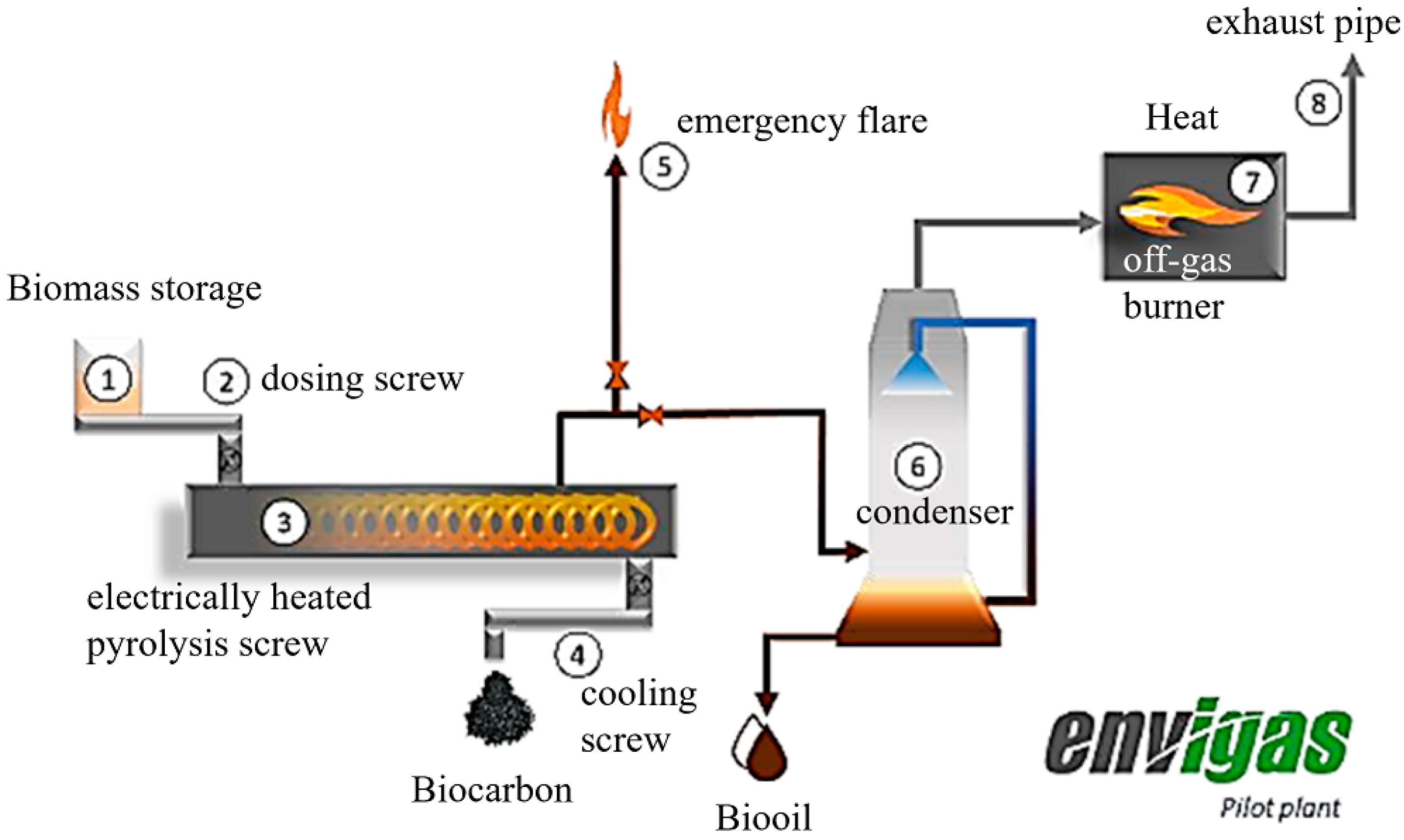
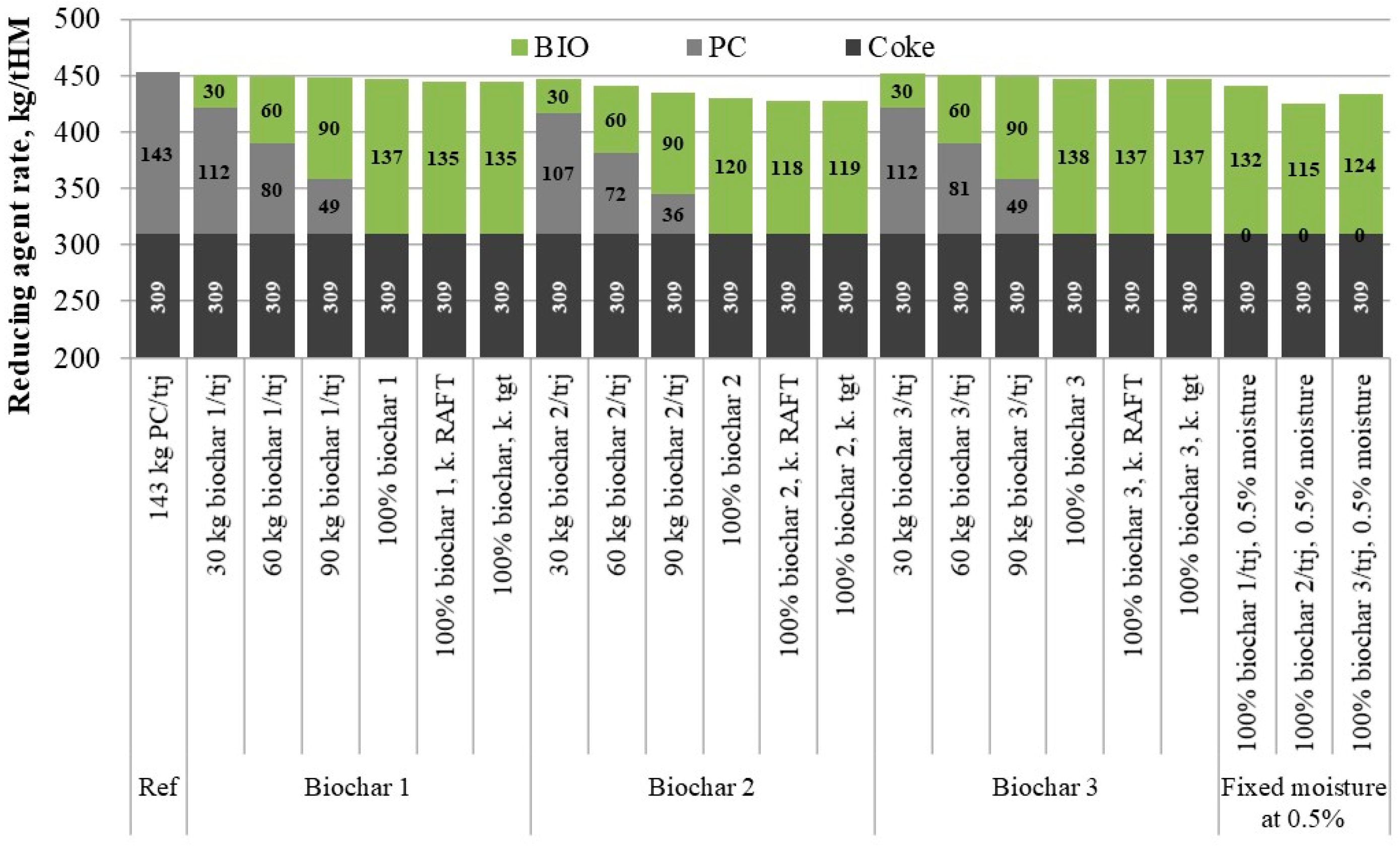
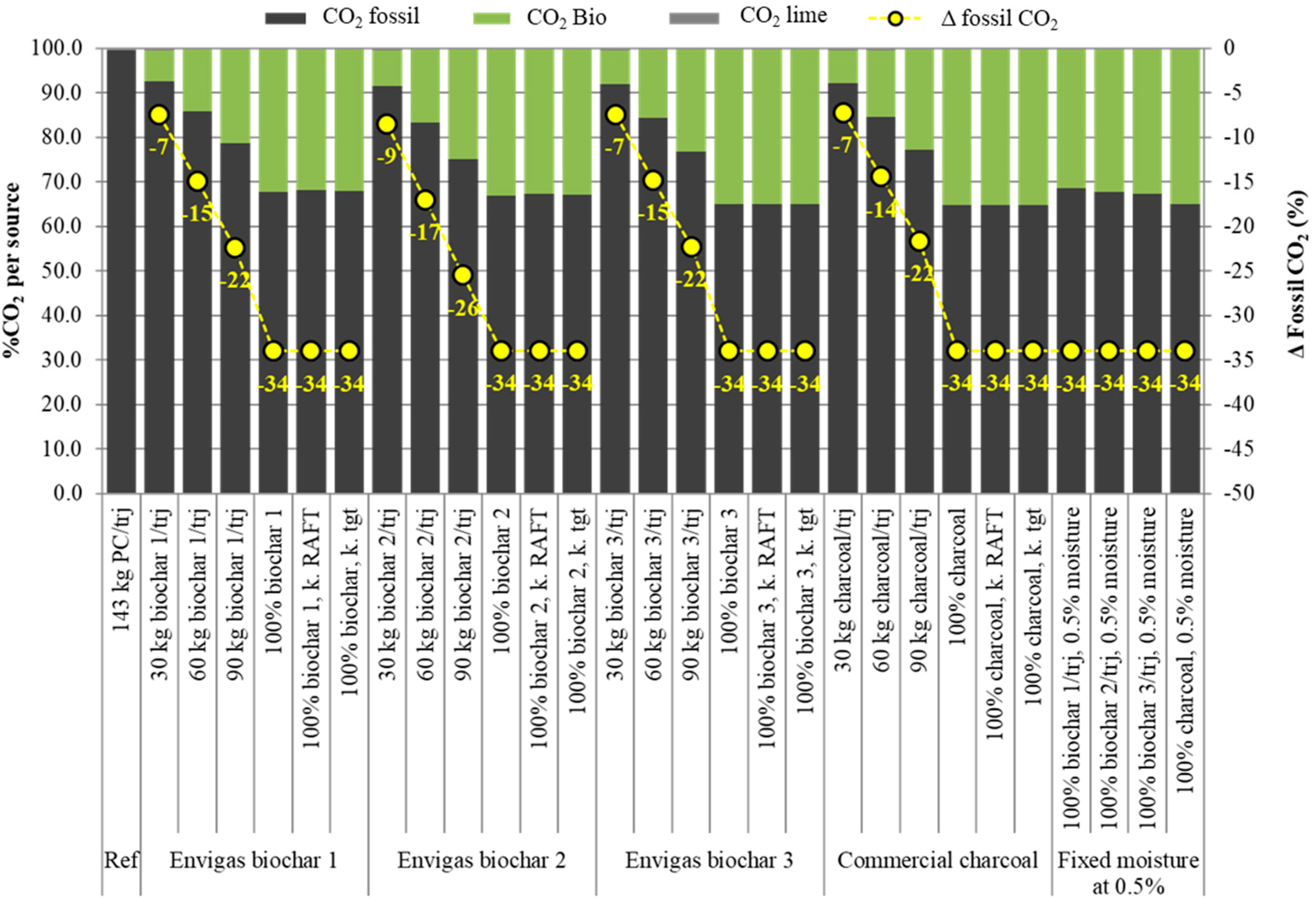
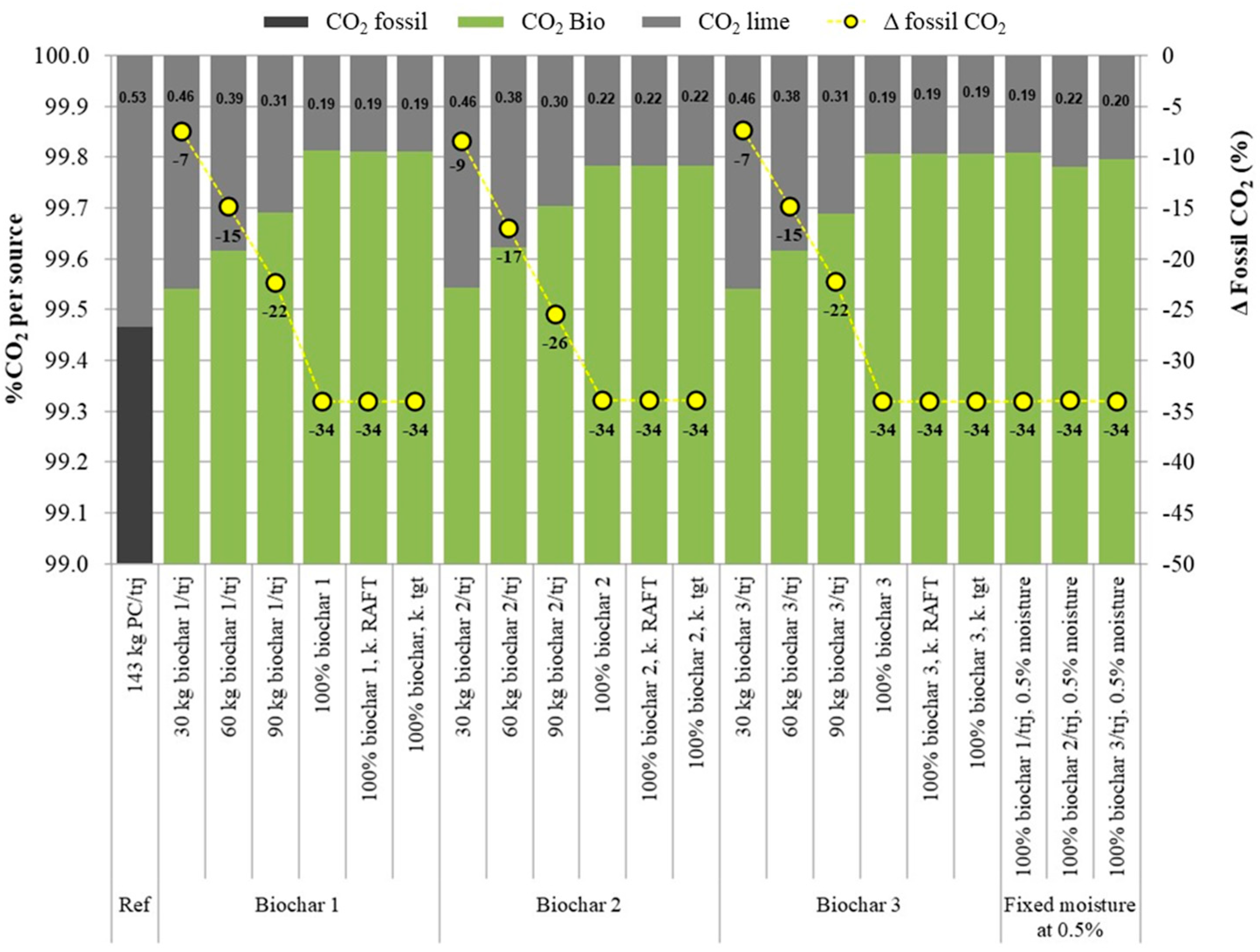

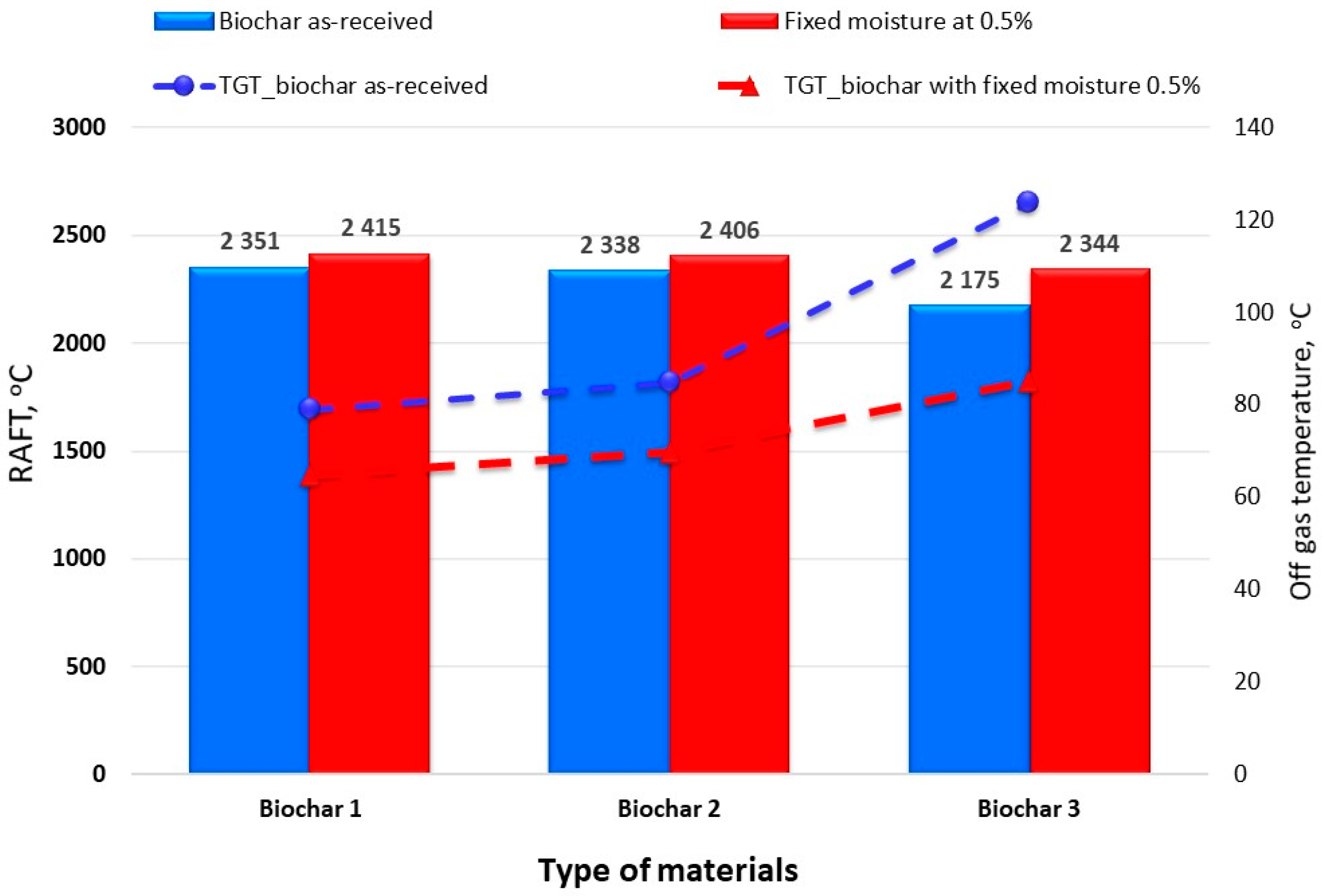
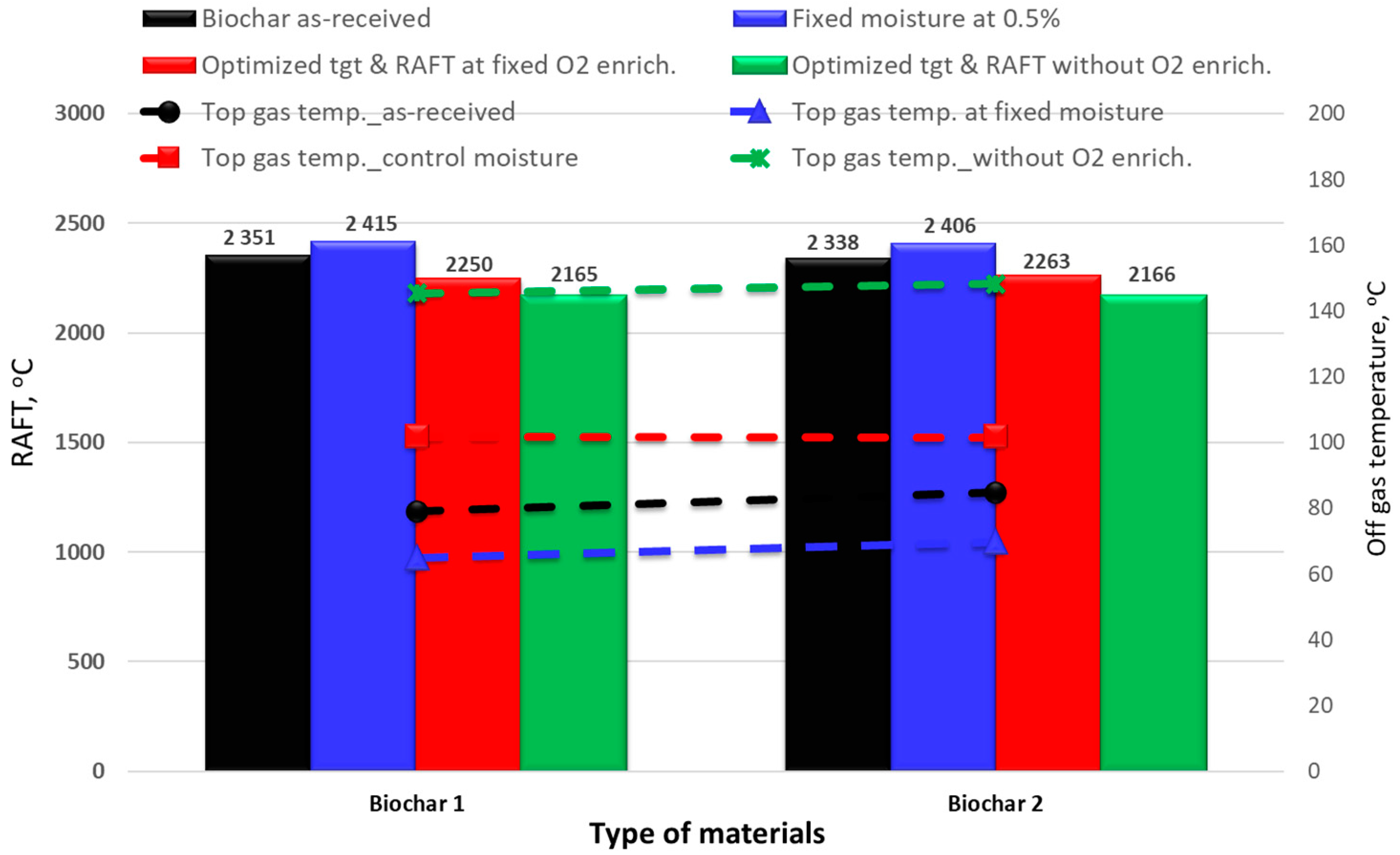
| Parameter | Unit | BF | Conditions |
|---|---|---|---|
| Feed & production rate | |||
| Coke | kg/tHM | 309.0 | Constant |
| PCI | kg/tHM | 143.0 | Varies with injected biochar |
| Limestone | kg/tHM | 15.7 | varied to adjust the slag basicity |
| Pellets | kg/tHM | 1331.5 | kept constant |
| LD slag | kg/tHM | 45.1 | kept constant |
| Injected dust | kg/tHM | 6.1 | kept constant |
| Briquettes | kg/tHM | 102.1 | kept constant |
| Production rate | tHM/h | 275.3 | kept constant |
| Operating conditions | |||
| Eta CO | % | 54.9 | varied |
| Eta H2 | % | 35.5 | kept constant as reference |
| Top gas temp. | °C | 124.0 | varied |
| Shaft efficiency | % | 95.1 | kept constant |
| Blast temp. | °C | 1076 | kept constant |
| TRZT | °C | 850 | kept constant |
| O2 in the blast | % | 4.17 | constant or varied |
| RAFT | °C | 2161 | constant or varied |
| Heat losses | MJ/tHM | 353.1 | kept constant |
| Heat losses distribution | % | 55.2 | kept constant |
| Ironmaking BF | Ref. | Biochar | ||||||
|---|---|---|---|---|---|---|---|---|
| Parameter | Unit | Case 1 | Case 2 | Case 3 | Case 4 | Case 5 | Case 6 | Case 7 |
| Bio injection | kg/tHM | 0 | 30 | 60 | 90 | 100% | 100% | 100% |
| PC injection | kg/tHM | 143 | Varies for constant coke | 0 | ||||
| O2 enrichment | % | 4.2 | 4.2 | 4.2 | Varies | Varies | ||
| RAFT | °C | 2162 | Varies | Varies | 2162 | Varies | ||
| Top gas temp | °C | 124 | Varies | Varies | Varies | 124 | ||
| PC | Biochar 1 | Biochar 2 | Biochar 3 | |
|---|---|---|---|---|
| wt.%, (db) | ||||
| CaO | 0.65 | 0.91 | 0.28 | 0.60 |
| MgO | 0.24 | 0.16 | 0.05 | 0.11 |
| SiO2 | 3.84 | 0.45 | 0.14 | 0.30 |
| Al2O3 | 1.92 | 0.09 | 0.03 | 0.06 |
| TiO2 | 0.06 | 0.08 | 0.02 | 0.05 |
| Na2O | 0.04 | 0.08 | 0.03 | 0.06 |
| K2O | 0.14 | 0.53 | 0.16 | 0.35 |
| S | 0.28 | 0.02 | 0.01 | 0.01 |
| P | 0.02 | 0.03 | 0.01 | 0.00 |
| Mn | 0.01 | 0.07 | 0.02 | 0.05 |
| Fe | 0.61 | 0.55 | 0.17 | 0.37 |
| C | 81.67 | 79.20 | 93.40 | 89.20 |
| H | 4.09 | 2.20 | 1.40 | 2.10 |
| O | 3.85 | 7.90 | 3.80 | 6.00 |
| N | 2.17 | 0.23 | 0.23 | 0.23 |
| Zn | 0.00 | 0.01 | 0.00 | 0.01 |
| Pb | 0.00 | 0.03 | 0.01 | 0.02 |
| Cl | 0.00 | 0.08 | 0.02 | 0.06 |
| Cr | 0.02 | 0.00 | 0.00 | 0.00 |
| Moisture | 0.50 | 5.40 | 6.40 | 13.10 |
| Ash | 8.00 | 4.20 | 1.30 | 2.80 |
| HHV_dry basis | 32.45 | 31.13 | 34.67 | 33.58 |
| LHV_dry basis | 28.81 | 30.69 | 34.39 | 33.12 |
| Type of Biocoal | Replacement Ratio_Moisture as Received | Replacement Ratio_Moisture Optimized at 0.5% |
|---|---|---|
| Biochar 1 | 1.04 | 1.08 |
| Biochar 2 | 1.19 | 1.24 |
| Biochar 3 | 1.04 | 1.16 |
| Optimization of RAFT & TGT for Biochar 1 & 2 | At 4.2% O2 Enrich | At 0% O2 Enrich |
| Moisture content, % | ||
| 12.0% | 8.5% | |
| Ref. | Biochar 3 (100% Replacement of PC) | |
|---|---|---|
| HM, t/h | 275.3 | 275.3 |
| Coke, kg/tHM | 309.0 | 309.0 |
| PCI, kg/tHM | 143.0 | 0.0 |
| Biochar, kg/tHM | 0.0 | 137.5 |
| Limestone, kg/tHM | 15.7 | 5.8 |
| Slag, kg/tHM | 168.5 | 154.7 |
| CO2 fossil, kg/tHM | 1270.5 | 838.2 |
| Annual limestone saved, ton | 0.0 | 23,968 |
| Annual slag saved, ton | 0.0 | 33,155 |
| Annual reduction of CO2, tons | 0.0 | 1,042,227 |
| Annual biochar needed, tons | 0.0 | 331,575 |
Publisher’s Note: MDPI stays neutral with regard to jurisdictional claims in published maps and institutional affiliations. |
© 2022 by the authors. Licensee MDPI, Basel, Switzerland. This article is an open access article distributed under the terms and conditions of the Creative Commons Attribution (CC BY) license (https://creativecommons.org/licenses/by/4.0/).
Share and Cite
Mousa, E.; Sjöblom, K. Modeling and Optimization of Biochar Injection into Blast Furnace to Mitigate the Fossil CO2 Emission. Sustainability 2022, 14, 2393. https://doi.org/10.3390/su14042393
Mousa E, Sjöblom K. Modeling and Optimization of Biochar Injection into Blast Furnace to Mitigate the Fossil CO2 Emission. Sustainability. 2022; 14(4):2393. https://doi.org/10.3390/su14042393
Chicago/Turabian StyleMousa, Elsayed, and Kurt Sjöblom. 2022. "Modeling and Optimization of Biochar Injection into Blast Furnace to Mitigate the Fossil CO2 Emission" Sustainability 14, no. 4: 2393. https://doi.org/10.3390/su14042393
APA StyleMousa, E., & Sjöblom, K. (2022). Modeling and Optimization of Biochar Injection into Blast Furnace to Mitigate the Fossil CO2 Emission. Sustainability, 14(4), 2393. https://doi.org/10.3390/su14042393







